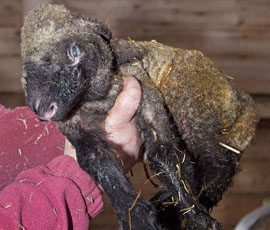Scientists develop new blood test for Schmallenberg

Scientists have developed a test that could be used to detect antibodies to the Schmallenberg virus in the blood of animals.
The Institute of Animal Health (IAH) at Pirbright, Surrey has heard from colleagues in France that they have developed a test that may be suitable to detect antibodies in the blood of living animals. However, there is still work to be done before the test is available for use.
The test could eventually be used to pinpoint animals that have been exposed to the virus, which could help scientists and vets better gauge the extent of infections.
The development is significant as until now, scientists have only been able to detect the virus on samples of still or newborn sheep and calves.
An IAH spokesman said the test has been developed by scientists working at the French company ID.Vet.
“The Schmallenberg virus is only in the blood of adults for two to three days, so this test could enable us to detect quickly which animals have been infected,” said the spokesman.
“The beauty with these ELISA (Enzyme linked Immunosorbent Assay) tests is that you can screen thousands of samples in one go using a robotic system, which would help us build up a clearer picture about the spread of the virus.”
NFU South East livestock board chair Howard Bates, a sheep farmer from Romney Marsh, in Kent, visited the institute in Pirbright as part of a NFU delegation last week.
He heard how scientists were working closely with their European colleagues to help our farming industry and there has been rapid progress on Schmallenberg.
“There is a diagnostic test to detect the virus in midges and animals and the IAH has just received news that colleagues elsewhere have developed a test that may be suitable for detection of antibodies in the blood of animals,” he said.
“The next step will be for this community of scientists to fine-tune the test so it can soon be deployed in the field. This will help farmers to pinpoint which animals have been exposed to the Schmallenberg virus and so have developed antibodies.”
NFU president Peter Kendall and vice-president Adam Quinney were part of the delegation that toured the institute.
They met Prof Peter Mertens, head of vector borne diseases at the IAH, and entomologist Dr Simon Carpenter.
The institute is researching how the Schmallenberg virus is replicated within midges and how it is passed on in differing climatic conditions.
Scientists believe Culicoides midges are the main vector transmitting the virus to cattle and sheep – but mosquitoes are also being studied.
The IAH is also working on a separate test to detect antibodies in the blood of animals and will use mathematics and computing to put all available data, including weather measurements and maps of the cases so far, together in order to understand how the disease has spread.
Mr Quinney stressed that livestock farmers must continue to work with their vets to submit fresh samples from suspected cases for testing, to ensure an accurate picture of disease spread across the country is built up.
“One of the best ways of scientists understanding this new virus is by farmers reporting suspected cases so that farmers can have the best information available to plan business and animal husbandry strategies”, he said.
Mr Kendall added: “It is fair to say that agricultural R&D has suffered in recent decades and this work highlights the need for investment in disease surveillance as this research can help in delivering the solutions to the challenges we face.”
John Fazakerley, director of the IAH, was pleased to welcome the group from the NFU.
“It’s vital that we understand how our research can be of benefit to end-users in the agricultural community,” said Prof Fazakerley.
“With an unfolding issue like Schmallenberg, good communication is essential and having the chance to discuss some of the issues face-to-face was extremely valuable.”
The Schmallenberg virus has now been found on 190 UK farms, according to the latest statistics from the Animal Health and Veterinary Laboratories Agency.
The AHVLA figures show that 176 sheep flocks and 14 cattle units have had cases of the disease, which causes deformities in newborn animals.
The IAH is currently benefiting from a multi-million pound redevelopment, as featured in Farmers Weekly.
For video and more information on the Schmallenberg virus
